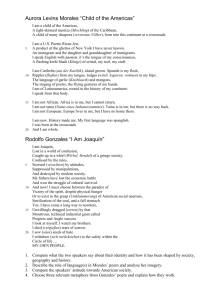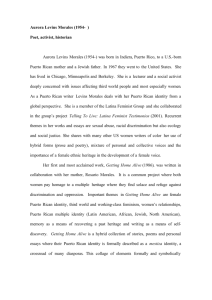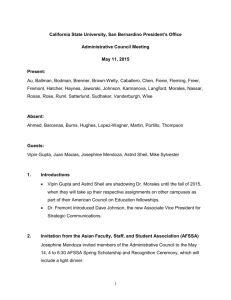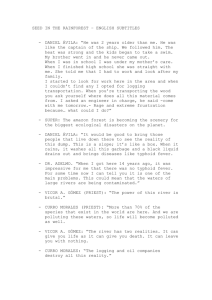Border Stories and Post-Nationalist American Identities: Reading
advertisement
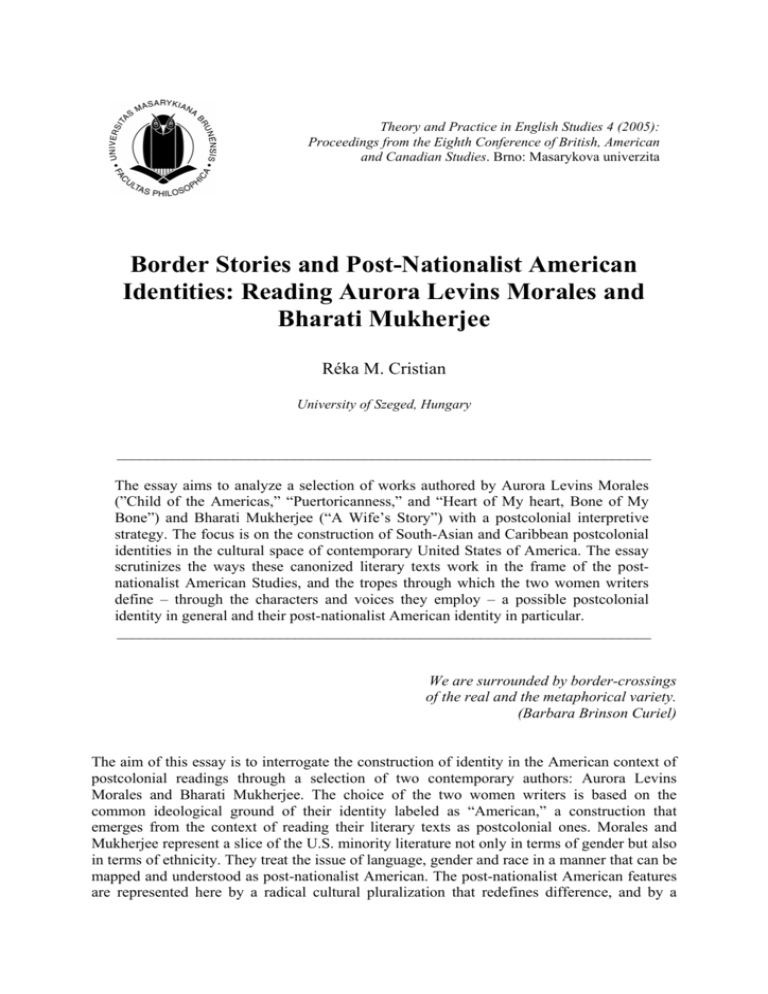
Theory and Practice in English Studies 4 (2005): Proceedings from the Eighth Conference of British, American and Canadian Studies. Brno: Masarykova univerzita Border Stories and Post-Nationalist American Identities: Reading Aurora Levins Morales and Bharati Mukherjee Réka M. Cristian University of Szeged, Hungary _____________________________________________________________________ The essay aims to analyze a selection of works authored by Aurora Levins Morales (”Child of the Americas,” “Puertoricanness,” and “Heart of My heart, Bone of My Bone”) and Bharati Mukherjee (“A Wife’s Story”) with a postcolonial interpretive strategy. The focus is on the construction of South-Asian and Caribbean postcolonial identities in the cultural space of contemporary United States of America. The essay scrutinizes the ways these canonized literary texts work in the frame of the postnationalist American Studies, and the tropes through which the two women writers define – through the characters and voices they employ – a possible postcolonial identity in general and their post-nationalist American identity in particular. _____________________________________________________________________ We are surrounded by border-crossings of the real and the metaphorical variety. (Barbara Brinson Curiel) The aim of this essay is to interrogate the construction of identity in the American context of postcolonial readings through a selection of two contemporary authors: Aurora Levins Morales and Bharati Mukherjee. The choice of the two women writers is based on the common ideological ground of their identity labeled as “American,” a construction that emerges from the context of reading their literary texts as postcolonial ones. Morales and Mukherjee represent a slice of the U.S. minority literature not only in terms of gender but also in terms of ethnicity. They treat the issue of language, gender and race in a manner that can be mapped and understood as post-nationalist American. The post-nationalist American features are represented here by a radical cultural pluralization that redefines difference, and by a Réka M. Cristian continual reshaping of mainstream and margins that contextualizes the paradigm of “newness.” Morales and Mukherjee, as ethnic women writers, are canonized in most recent anthologies of American literature. “The Heath Anthology of American Literature” (gen. ed. Paul Lauter, Vol. II) for example, includes the poems and the short prose of Morales in the chapter “New Communities, New Identities, and New Energies,” while Mukherjee’s short story is included in the chapter “Postmodernity and Difference: Promises and Threats” (emphasis added). In this context both authors are “new” through the “difference” they present and through the multiculturalist challenge they pose to the mainstream literature. For these two women authors Americanness implies being both ethnic/“different” and hybrid/“new” at the same time. In other words, newness and difference as postcolonial features construct a post-nationalist identity, that of the contemporary “American.” The literary texts of Morales and Mukherjee depict “new” and “different” individual identity constructions also by crossing the boundaries of disciplines. Accordingly, their writings can be considered, to use Brinson Curiel’s term, American “border stories.” Besides being interdisciplinary, these texts provide critical insights into the contradictions inherent in a variety of aspects of American life and culture. These works constitute “a series of boundary crossings” because they are descriptive and critical at the same time, and reveal a flexible facet in their “cross-cultural, transnational, translocal, diasporic perspectives” (Boyce Davies 1998: 996), a flexibility that is innate within the American culture itself. On the basis of their transgressive ideological content these “border stories” fit mostly in the category of the socalled postcolonial texts. The term postcolonialism has recently become so “heterogeneous and diffuse” (Loomba 1998: xii) because of its interdisciplinary nature that is more and more problematic to describe its scopes and methods. Even its English spelling is varied, the term sometimes appears hyphenated, sometimes not, depending on the shifting definitions of the term. Due to the problems the term poses, there is a growing academic suspicion in the U.S. and worldwide about the overlapping of the studies labeled as postcolonial with those of Ethnic Studies. In the introduction to the chapter on “Ethnic Studies, Post-Coloniality, and International Studies” Julie Rivkin and Michael Ryan, claim that the “thinkers in the field of post-colonial studies tend to be more skeptical of deals of ethnic identity than PostStructuralist philosophers outside the field” (Rivkin and Ryan 1998: 855). The term “Ethnic Studies” is yet another problematic one. In some sense, it is as restrictive as the discourse of colonialism itself, namely because it “reinforces the counterproductive idea that whites and the middle class have no culture, and that only some (‘other’) groups of people have noteworthy social and cultural experiences” (Brinson Curiel 2000: 216). New Americanists and thinkers in the field of Post-nationalist American Studies use the term for “a field which has evolved through the study of specific, and shifting, American cultural, racialized, and socioeconomic groups, which has been institutionalized in American universities and colleges typically under the Ethnic Studies rubric” (Brinson Curiel 2000: 216). In my discussion about the works of Morales and Mukherjee I will use the term “postcolonial” instead of the “ethnic” because while the second has its ideological limitations, the first term bears a more complex connotation that better suits recent cultural discourse of the United States and provides a step forward in understanding the construction of the post-nationalist American identity. In the context of contemporary cultural practices in the United States it is the mostly the postcolonial theory that questions the complex intersection of ideological and materialistic issues of the nation, race, language, and gender. When studying an American literary text from the perspective of the postcolonial context it is suggested that one take into consideration the person of the author. To paraphrase Gloria Anzaldúa, what validates one as a human being validates one as writer, too. Recent American literary anthologies are built in such a manner as to present the reader with a biographical bird’s eye view about the life of the writer before the actual literary text. Sometimes fiction and non-fiction border each other in 36 Border Stories and Post-Nationalist American Identities: Reading Aurora Levins Morales and Bharati Mukherjee texts that provide authorial background and/or implicit or explicit reference to autobiography, as it is the general case of memoirs, of women’s writing, of gay and lesbian or queer literature, postcolonial texts, etc. In other words, the boundary between fiction and non-fiction is constituted in the process of transgressing generic borders (Brinson Curiel 204). Most contemporary American literary texts that subscribe to the context of the postcolonial in the case of identity construction (minority literatures) refer to the origins best represented as personal experience, life stories, and are thus, to a certain extent intentionally autobiographical. Contemporary feminist critique – as cultural politics rather than a theory of theories – considers that there is not one grand, objective narrative par excellence but many petits récits, that is, small stories, narratives that are “scattered and grounded in specific cultural-political realms” (Cristian 2002: 46) that help one build the roots of identity. In Kathleen Stewart’s words, these stories written from the otherness of the cultural margins whether ethnic, racial or gender ones are “spaces on the side of the road” that help define themselves by defining also the “road” itself (Stewart 1996: 7). Morales and Mukherjee are authors that wrote texts that can be read and interpreted as “border stories” and “spaces on the side of the road” both because of the inherent autobiographical and of the ethnic/postcolonial content that reevaluates the sides/margins and the road/center. Aurora Levins Morales (b. 1954 in Puerto Rico) is an American writer of Jewish and Puerto Rican mixed ancestry. Her works focus on the cultural cross-fertilization between the North Anglo-American literary tradition and the Latin American and Caribbean cultures. The poems and the short prose of Morales are “border stories” in the sense that they interrogate a variety of cultural frames that place identity at the crossroads of specific terrains. In “Child of the Americas” the poetess uses specific, confessional language and places this stylistic and linguistic competence at the core of identity construction. Morales’s lyrical I, written in first person singular, suggests a powerful autobiographical implication. The lyrical I is a contemporary complex ethnic mixture, the voice of a “light skinned mestiza of the Caribbean” and a “U.S. Puerto Rican Jew” that communicates her racial and religious identity in a specific English, which is “the tongue of [her] consciousness” (Morales 1994: 2814). The I of the poem defines herself as a “space on the side of the road” when she refers to geographical tropes while constructing her identity as “CaribeĖa.” The Caribbean region’s “politico-linguistic geography” (Appiah 1998: 950) beside that of the island of Puerto Rico and the U.S. as such, is part of the rhetoric Morales employs in order to show the “idiosyncracies of her nature” (Morales 1994: 2816). The Caribbean is a region of multiplicity, an archipelago that is “built” at ideological, cultural, political and geographical crossroads, a complex vista of hybrid ancestry, a place of postcolonial otherness. Identity is not a simple matter here. For Morales it is defined as the negation of certain origins, and thus as a negation of any homogenous, compact, national “imagined community” (Benedict Anderson). The use of small letters in the case of origins depicted as “african,” “taina,” or “european” exceeds fixed postcolonial paradigms that reinforce the idea of an ideal origin. Identity is constructed in terms of what the self-reflexive individual is “not,” and rather of what content the self contains from given places and cultures: I am not african. Africa is in me, but I cannot return. I am not taina. Taino is in me, but there is no way back. I am not european. Europe lives in me, but I have no home there. (Morales 1994: 2815) The threefold negation of any homogenous origin ends in another definition of identity as “new.” What Morales defines here is the identity of the “American,” where “newness” is uncertain in terms of ethnicity and very much certain of what citizenship encapsulates under 37 Réka M. Cristian the administrative term of nationality. The conclusive metaphor of the “new” implies a former existence of borders among “older,” “earlier” languages and geopolitical zones, as well as among races. The “earlier” English and Spanish, as the hegemonic languages of the colonizers and conquistadores, converge into a hybrid language, that of the “spanglish,” that symbolizes a “new” identity for the mestiza as a complex and integral individual: I am new. History made me. My first language was spanglish. I was born at the crossroads and I am whole.” (Morales 1994: 2815) The transgressive lyrical journey Morales performs through these borders build up the “crossroads” of her own identity. Morales’s “border story” in “Child of the Americas” defines identity in terms of a “new” hybrid at the crossroads of American cultures. The crossroads is the place from where identity is best mapped, and also the name of a current comprehensible American Studies Project on the Internet encompassing the multitude of approaches to what “American” might mean inside and outside the country. The prose that further enriches Morales’s textual identity as “American” within the postcolonial context is “Puertoricanness.” Here the author uses the mixture of Spanish and English to give flavor to her identity seen as an “island” in the midst of similar identities. The life in the cultural borderlands involves a linguistic “intimate terrorism,” (Anzaldúa 1994: 891), one that overcomes the “tradition of silence” (Anzaldúa 1994: 894). “Puertoricanness” shows the ambiguity and duality of the person living at the border of two languages and cultures, it sheds light on the possibilities of transgressing the boundaries between silence and language in an act of literary hybridization. In “Borderland/La Frontera: The New Mestiza” Gloria Anzaldúa calls this type of language el lenguaje de la frontera, the language of the border. Morales employs a similar border language in “Puertoricanness” in the case of a Puerto Rican woman living in the U.S. This woman imports the Caribbean, Latino culture with the words, plants, food, sounds and the culinary taste of her native land into a functional border language that fuses Spanish and English into a hybrid “exchange” that becomes “American:” […] she could right now, in the endless bartering of a woman with two countries, bring herself to trade in one-half of her heart for the other, exchange this loneliness for another perhaps harsher one, she would live as Puerto Rican lives en la isla [on the island], right here in north Oakland, plant the bananales [banana plants] and cafetales [coffee trees] of her heart around her bedroom door, sleep under the shadow of their bloom and the carving hoarseness of the roosters, wake to the blue-rimmed white enamel cups of jugo de pina [pineapple juice] and plates of guineo verde [green bananas or Plaintains], and heat pots of rice with bits of meat in them on the stove all day. (Morales 1994: 2816) As a Puerto Rican nativist the “she” of the prose inhabits a “Western architecture” (Appiah 1998: 953) in order to tell herself out of silence. This Western architecture imposes a special syntax on the written text but stops working when it comes to Caribbean words of Spanish origin. To make the narrative seamlessly work the text in “The Heath Anthology of American Literature” provides these “foreign,” ethnic words with footnotes of their English translation. The use of unrestricted bilingualism is Morales’s best example of “spanglish” as border language. The “Latinoamerican” spirit here is similar to that of the twonness of AfricanAmericans, who according to W.E.B. DuBois, hold a double consciousness, that of being of black and American at the same time. The elements combining the identity of the Puerto 38 Border Stories and Post-Nationalist American Identities: Reading Aurora Levins Morales and Bharati Mukherjee Rican woman in the U.S. appear in this short Latina écriture feminine as the Caribbean “soup of signs” one has to combine linguistically and culturally in order to understand the essence of a possible postcolonial identity that Benítez-Rojo calls the “union the diverse” (Benítez-Rojo 1998: 979). Morales’s identity resembles – though her texts – to “a cultural meta-archipelago without center and without limits” that presents the person of the lyrical I (or that of the narrated, or even that of the narrator) metaphorically as a “repeating island,” one that “proliferates endlessly” (Benítez-Rojo 1998: 985) when it comes to define identity in terms of linguistic, racial or gender borders. However plain it might sound Morales is postcolonially “American.” For Morales being “CaribeĖa” or “Puertorican” means being an individual that has been “born” at the “crossroads,” that had been made “whole.” This integrity exists because the subject to which it refers is not the product of a single homogenous culture, but is rather a “child of the Americas.” “Americas” with plural meaning means a virtual place with no generic borders (or with transgressable borders) that overcomes any geographical categorization, and covers the issue of identity as being manifold “American.” In a similar context, when she discusses the migration of the Latino population and the border-crossings of the Mexicans to the U.S. Brinson Curiel discovers – similar to Morales – that, after the actual act of crossing the border, in the process of shaping the identity as “American” one needs to consider the implied elements of cultural and linguistic transgressions. These are, Brinson Curiel claims, inherent within the American Dream itself and define the migrant identity as “American:” This other message about border-crossing, in this case about scaling the wall between languages, is integral to the American dream and is used to capture and influence the spending habits of Latino immigrants. (Brinson Curiel 2000: 201) Bharati Mukherjee (b. 1940 in Calcutta) is the other author who transgresses cultural borders in shaping the identity of her characters. Mukherjee established herself as one of the most important South Asian American woman writers while she defined herself primarily as an American writer. “A Wife’s Story” is an incursion into the American way of life as the starting point in the character’s post-nationalist identity construction. This short story is about Panna Bhatt, who comes from India to New York to study with a scholarship. The narrative follows her psychological and social development as individual within American urban culture. While abundant ethnic and cultural references to her own culture seem to govern her way of life, Panna is also eager to meet, understand and connect to a complex web of other cultures. The married woman of Indian origin relates her old self from the beginning of the narrative and new self from the end of the short story to the persons she meets in the American metropolis with only occasional references to people of her former home. The traditional patriarchal India with its cast system has been partly obscured under an uncanny veil of melancholic narrative flashbacks, while New York is from the beginning for Panna a place of explicit complex cultural construct where she meets a high degree of personal freedom. Mukherjee’s prose depicts this metropolitan context in the mediation of “ethnic” characters of diverse origins. Panna’s best friend is Imre, a Hungarian whom the protagonist considers another Asian because he is “a Magyar,” which for Panna induces a virtual hypothesis that “deep down he’s an Asian, too” (Mukherjee 1994: 3106). To emphasize Imre’s Asian origin – and, what is more, to explain the deep friendship with this man – Panna seeks for racial features that would help her localize the origins of her best friend. She sees in Imre the “union of the diverse,” a kind of East meeting West. Panna notes: “I catch glimpse of it, knife-blade Attila cheekbones, despite the blondish hair” (Mukherjee 1994: 3106). The 39 Réka M. Cristian stereotypes referring to “knife-blade Attila cheekbones” allude to Imre’s latent Asian origin, while his “blondish hair” symbolizes in this context, the Western background and education. Imre is indeed a Westernized figure in the sense that he knows and lives by cultural Western canons. With the implied Asian reference he is Panna’s ironic embodiment through whom she projects her own cultural “borderland” identity in the making. At the end of the short story, Panna does not need Imre’s sublimated mediation nor him as a possible mirror to her identity construction, she will see and acknowledge her “new” identity that appears in the guise of the mirror image of the “wife.” Another figure of Panna’s “ethnic” panopticon is the Chinese Charity Chin, Panna’s flat mate. Charity is presented as a completely westernized figure. She is already an Americanized career woman, a hands model, married to an American man and dating another American. Panna sees Charity through stereotypical lens, and despite the fact that they share the same flat, the two women do not have anything in common, despite their actual Asian origin. Later in the narrative there are cameo appearances of other ethnicities. During the trip Panna and her husband take around Manhattan, they encounter a “large Oriental family” and “a Japanese matron.” The term Oriental is of queer reference here and it might denote an ethnicity beyond that of the Chinese and the Japanese, which seem to have a set paradigmatic references for Panna. To further color the ethnic patchwork, the author inserts the figure of another East European man, Goran “from Yugoslavia.” It is through this figure – and Imre’s information – that Panna interrogates the issue of European “white muslims” from the Balkans through whom the question of cultural complexity come also in focus. Panna’s encounters with the Hungarian, Chinese, Yugoslavian, and Oriental (whatever the term means here) characters provide a signifying chain in the construction of Panna’s American urban experience and identity. Panna defines herself mostly in terms of what the others whom she encounters – are. “Asian” is a term she reserves as trope of the “home” for Imre and herself. All the characters in the short story are alternative, hybrid figures to whom she relates her cultural “otherness,” as a South Asian in the U.S. The relationship with these characters show plural facets of Panna’s identity as “American” from the perspective of her old cultural habits and even stereotypes. Mukherjee’s New York is a postcolonial space of multiple ethnical contexts and is a point of cultural convergence similar to the Caribbean region of Morales. According to Panna’s husband, who is representative of the patriarchal, ethnic South Asian, Indian culture, New York City resembles Bombay because, in its human and historical complexity, it presents similar features to the former British colony: “New York is full of cheats and whatnot. Just like Bombay.” (Mukherjee 1994: 3114) The similitude with Bombay brings even the image of New York as a possible postcolonial place. It is right there, in the heart of the American metropolis where “the empire strikes back” through Mr. Bhatt’s words. It is this context where Panna, a “well-bred displaced Third World” woman (Mukherjee 1994: 3106), has to find her “new” identity on the grounds of multiracial, multiethnic American culture. Panna is already taken for an “American” by a “dark man, Lebanese probably,” who (mis)identifies her as a “Puerto Rican” (Mukherjee 1994: 3111). She is on her best way to finalize her post-nationalist American identity project at the moment when she refuses to go home and settles in the U.S. despite the husband’s frequent requests. Finally her husband leaves and she recognizes her new, Americanized self. “A Wife’s Story” concludes with a focus on the figure of Panna, contemplating herself naked in the mirror: “I am free, afloat, watching somebody else” (Mukherjee 1994: 3114). Panna’s story and the stories of her friends are among the “alternative histories of the excluded” (Bhabha 1998: 937) which finally meet in a cultural patchwork that is made up in an urban collage of the “spaces from the side of the road.” These spaces are, in Kathleen Stewart’s definition, places where “otherness” is best articulated and newness best achieved. “A Wife’s Story” is such a textual 40 Border Stories and Post-Nationalist American Identities: Reading Aurora Levins Morales and Bharati Mukherjee space – in terms of ethnicity and gender – that has been brought from the “side” to “the road” by being placed in the literary canon of the contemporary U.S. While Morales constructs identity as “American” in the “new” self as “a whole” at the “crossroads” of Americas, Mukherjee’s Panna defines “American” in becoming “someone else.” Morales’ lyrical I is hybrid while crossing cultural and linguistic borders, Mukherjee’s Panna is narcissistically “other” when she starts to encounter herself as American at the moment she decides to remain in the U.S. and not to cross any cultural or national borders. The perspectives of both authors aim to view identity construction on contemporary America while defining their own identity through literary texts. And since the definition of their identity is postcolonial by means of implied ethnicity and cultural transgression within the U.S, the definition of America and implicitly “American” becomes a matter of postcolonial definition, too. Implying an inverse method of identity introspection, Morales, as one born within the political borders of the U.S., defines herself as American from the “outside,” that is, from region of the Caribbean and realms of origins. Mukherjee, as one who was born outside the U.S., defines herself and Panna from “inside” America. For Morales, identity as “American” is the crossroads product of a border language at the level of the individual, and a border story. For Mukherjee the concept of “American” implies a sense of cosmopolitan place at the level of the reflexive immigrant. For both authors ethnicity implies borders, metaphorical or not, and these borders lead to a new construct the reader interprets as “American.” The syncreticism of the interdisciplinary, culturally complex America in the above-mentioned texts can be read as the self’s “new” construct of Morales, or Panna’s newness of identity as “someone else.” The discussed works of are cultural border stories in American culture. They re-contextualize the sense of the “new” because they are at the same time acts of post-national identity formation and processes of “cultural translation” (Bhabha 1998: 938). The postcolonial readings of these canonized contemporary American texts by women writers make up a possible category that promotes creative dissensus (rather than consensus) and alterity (rather than conformity) in the American literary canon and in the shaping of the post-national American identity. This is the category a third, postcolonial space where “non-consensual forms of affiliations” can and are established (Bhabha 1998: 941). When defining “American” here in the context of postcolonial readings exercised on canonized American texts one must be aware that the “concepts of homogenous national cultures, the consensual or contiguous transmission of historical traditions, or ‘organic’ ethnic communities – as the grounds of cultural comparativism – are in profound process of redefinition” (Bhabha 1998: 936). The categories of identity are made “salient by dominant cultural codes” (Barrett 2002: 305). They intersect, transfigure, and continually redefine each other, as the example of Morales and Mukherjee above has shown. Anzaldúa laments about this necessity of producing new paradigms when she says that through acts of interpretation “they chop me into little fragments and tag each with a label” (qtd. in Barrett 2002: 305). The postcolonial theory has been keen in labeling one ethnic and building theories of ethnicity on the basis of these theoretical “labels.” Morales and Mukherjee exceed this explicit theoretical or practical labeling because their works present American identities that transcend the boundaries of the postcolonial context while being grounded in these. To paraphrase Gayatri Chakravorty Spivak, this reflects a position that can be best described as the politics of the open end. Postcolonial identities and post-nationalistic American identities are not mutually exclusive because “as much as ethnic/racial formations prove dissociative or diacritical, they are also profoundly syncretic” (Barrett 2002: 305). It is this syncreticism that forms the basis of what can be read as post-nationalist “American.” 41 Réka M. Cristian Works Cited Anzaldúa, Gloria (1998) ‘Borderlands/La Frontera’ in Rivkin, Julie and Ryan, Michael (eds) Literary Theory: An Anthology, Malden: Blackwell: 887-902 Appiah, Anthony ‘Topologies of Nativism’ in Rivkin, Julie and Ryan, Michael (eds) Literary Theory: An Anthology, Malden: Blackwell: 945-957. Barrett, Lindon (2002) ‘Identity and Identity Studies: Reading Toni Cade Bambara’s ‘The Hammer Man’.’ in Pease, Donald E. and Wiegman, Roby (eds) The Futures of American Studies, Durham: Duke UP: 305-326. Benítez-Rojo, Antonio (1998) ‘The Repeating Island’ in Rivkin, Julie and Ryan, Michael (eds) Literary Theory: An Anthology, Malden: Blackwell: 978-995. Bhabha, H. K. (1998) ‘The Location of Culture’ in Rivkin, Julie and Ryan, Michael (eds) Literary Theory: An Anthology, Malden: Blackwell: 936-944. Brinson Curiel, Barbara (2000) ‘My Border Stories: Life Narratives, Interdisciplinarity, and Post-Nationalism in Ethnic Studies’ in Rowe, John Carlos (ed) Post-Nationalist American Studies. Berkeley: California UP: 200-218. Cristian, Réka M. (2002) ‘Telling Woman: Historias Orales de Mujeres Húngaras’ (trans. Servando Ortoll) Estudios Sobre Las Culturas Contemporaneas. Programa Cultura: Revista de investigation y análisis. Centro Universitario de Investigationes Sociales. Universidad de Colima. Mexico. Epoca II, Vol.VII, Nr: 16, Dicimbre 2002. 37-53. Davies, Carole Boyce (1998) ‘Migratory Subjectivities’ in Rivkin, Julie and Ryan, Michael (eds) Literary Theory: An Anthology, Malden: Blackwell: 996-1015. Loomba, Ania (1998) Colonialism/Postcolonialism. London: Routledge. Morales, Aurora Levins (1994) “Child of the Americas” “Puertoricanness” “Heart of My heart, Bone of My Bone” in Lauter, Paul (gen. ed.) The Heath Anthology of American Literature, vol.II., Lexington: D.C. Heath and Company: 2814-2918. Mukherjee, Bharati (1994) ‘A Wife’s Story’ in Lauter, Paul (gen. ed.) The Heath Anthology of American Literature, vol. II., Lexington: D.C. Heath and Company: 3105-3114. Rojo, Benitez ‘The Repeating Island’ in Rivkin, Julie and Ryan, Michael (eds) Literary Theory: An Anthology, Malden: Blackwell: 978-995. Rivkin, Julie and Ryan, Michael. (1998) ‘English Without Shadows, Literature on a World Scale’ in Rivkin, Julie and Ryan, Michael (eds) Literary Theory: An Anthology, Malden: Blackwell: 850-855. Stewart, Kathleen (1996) A Space on the Side of the Road. Cultural Poetics in an “Other”America. Princeton, Princeton University Press. 42
